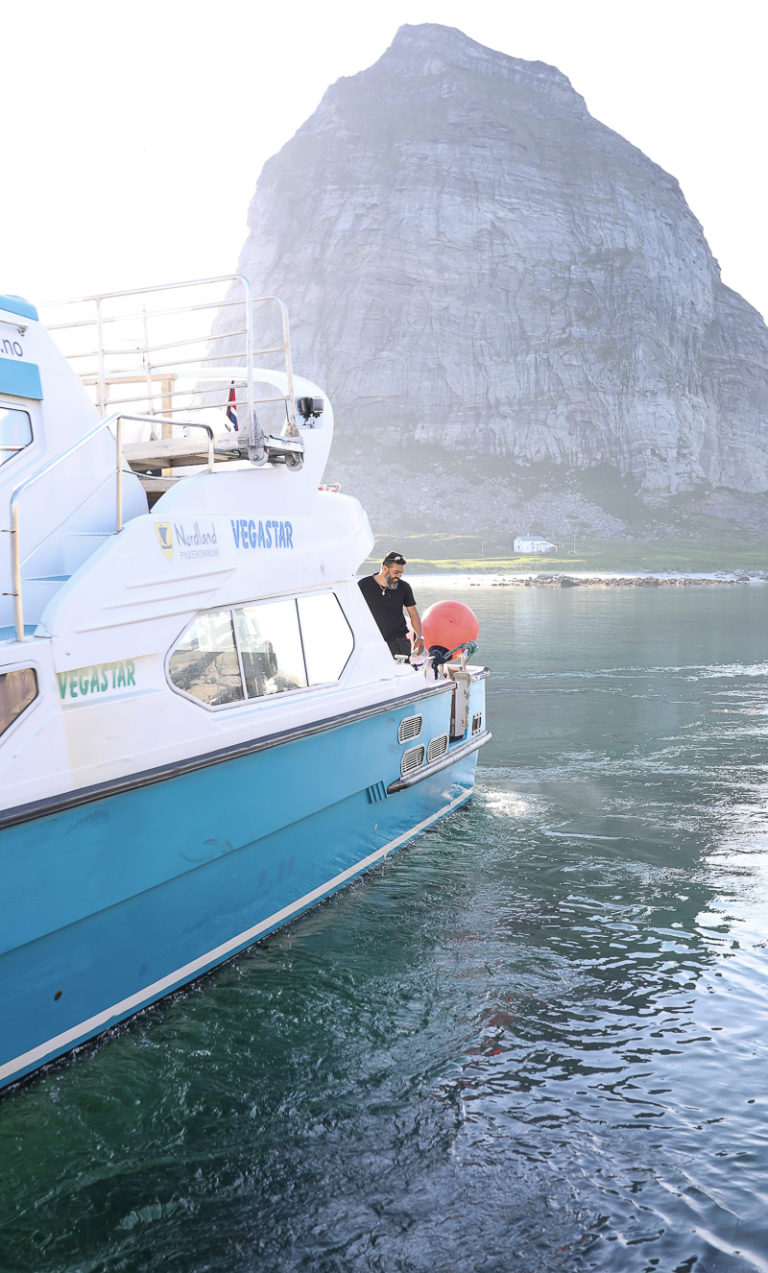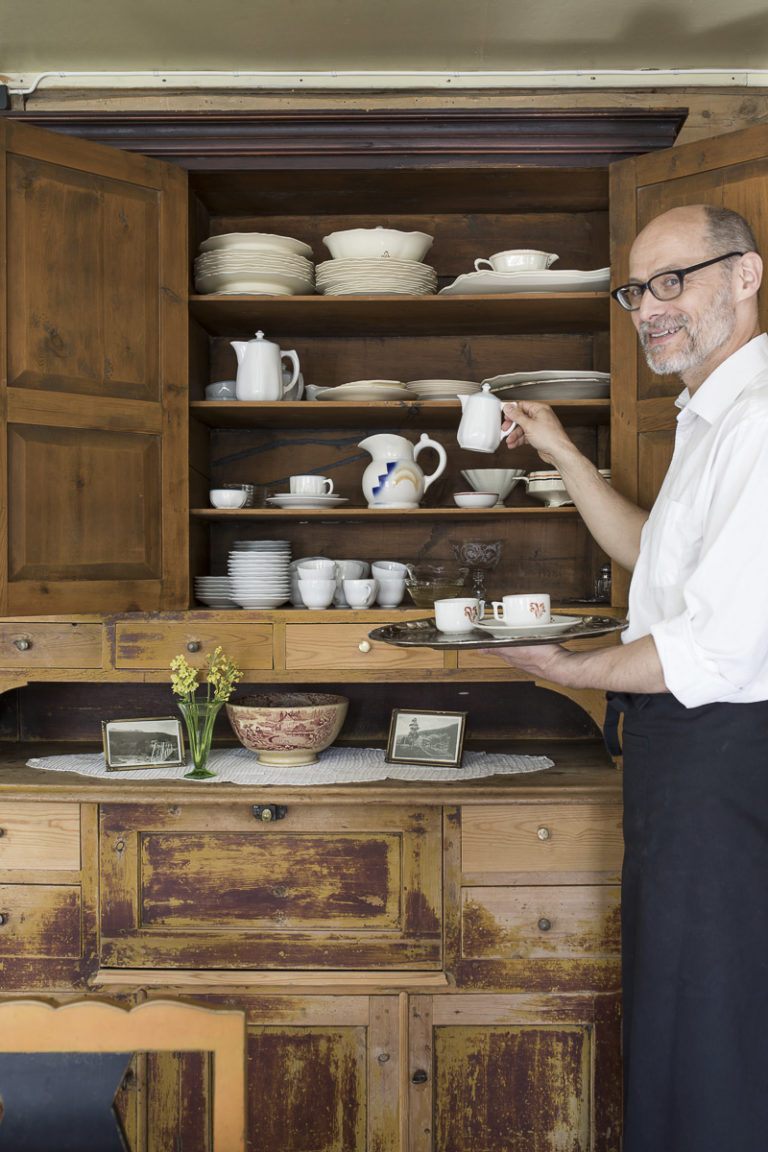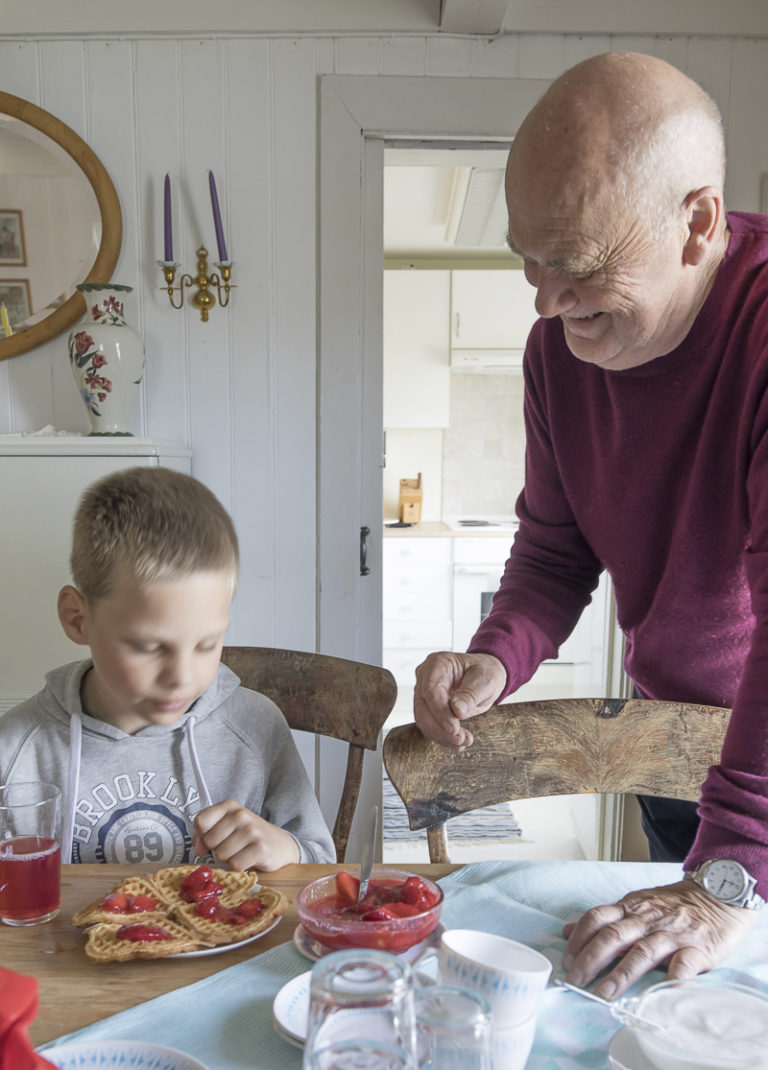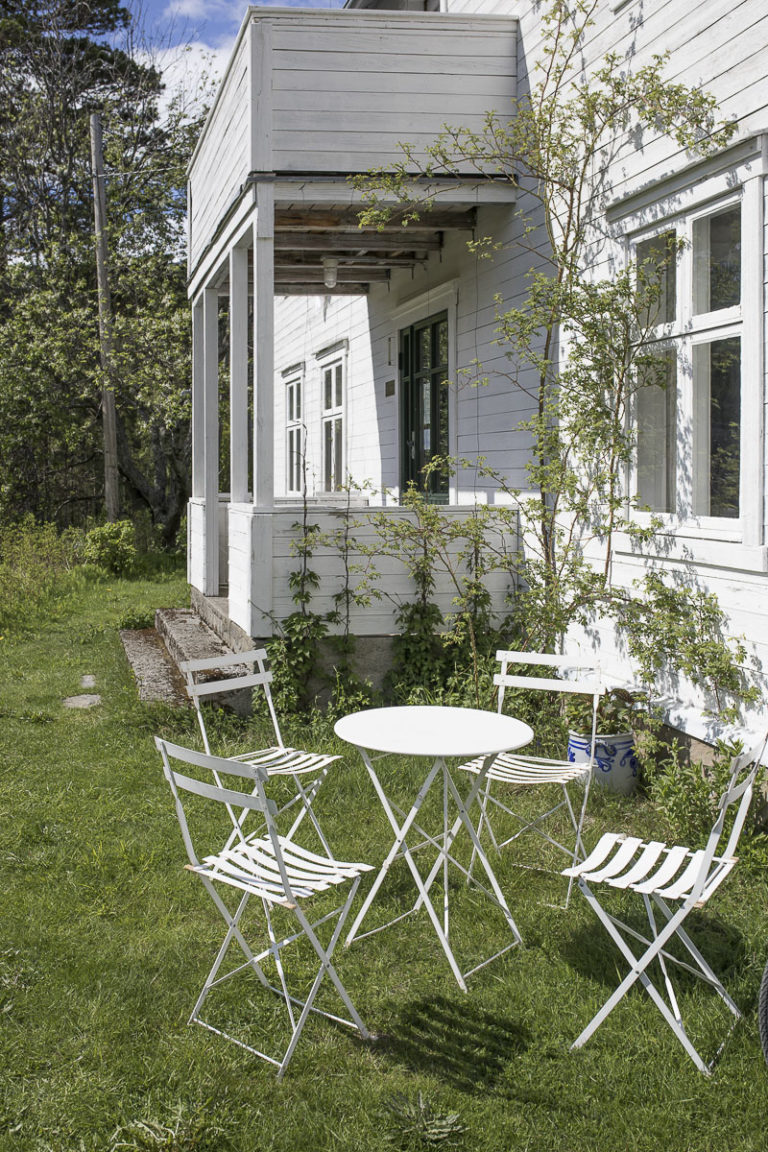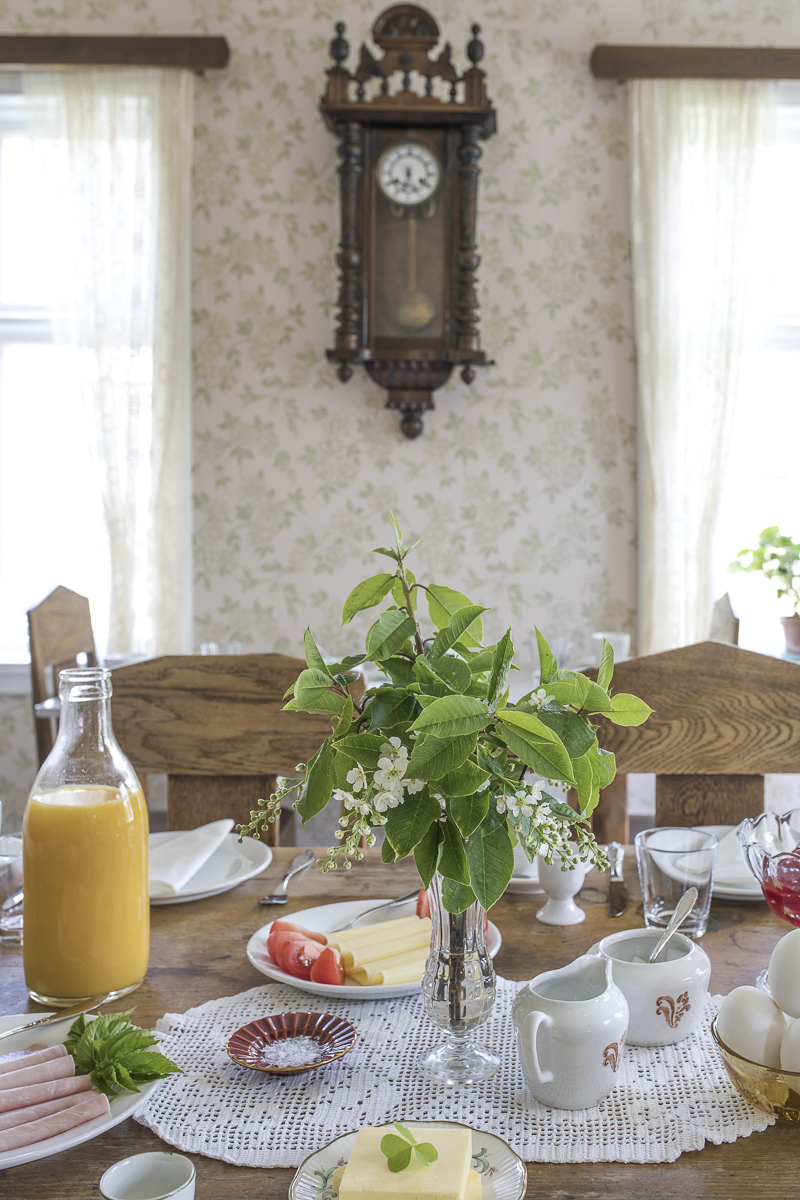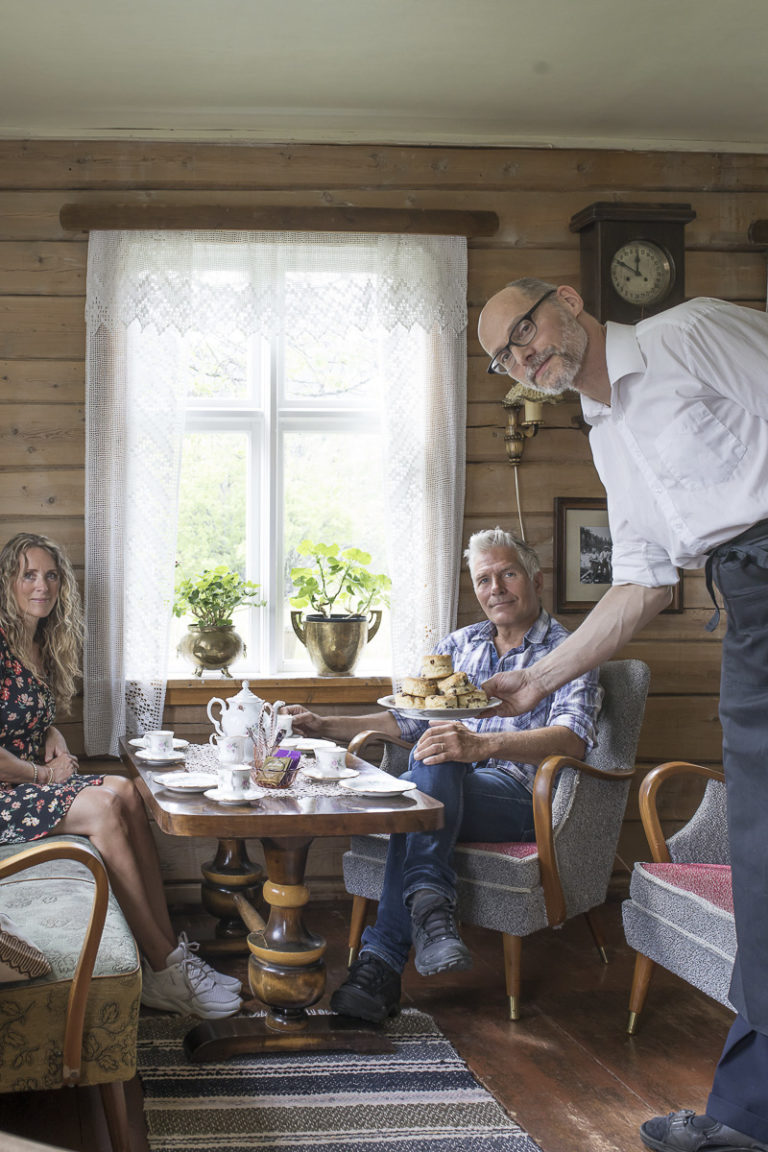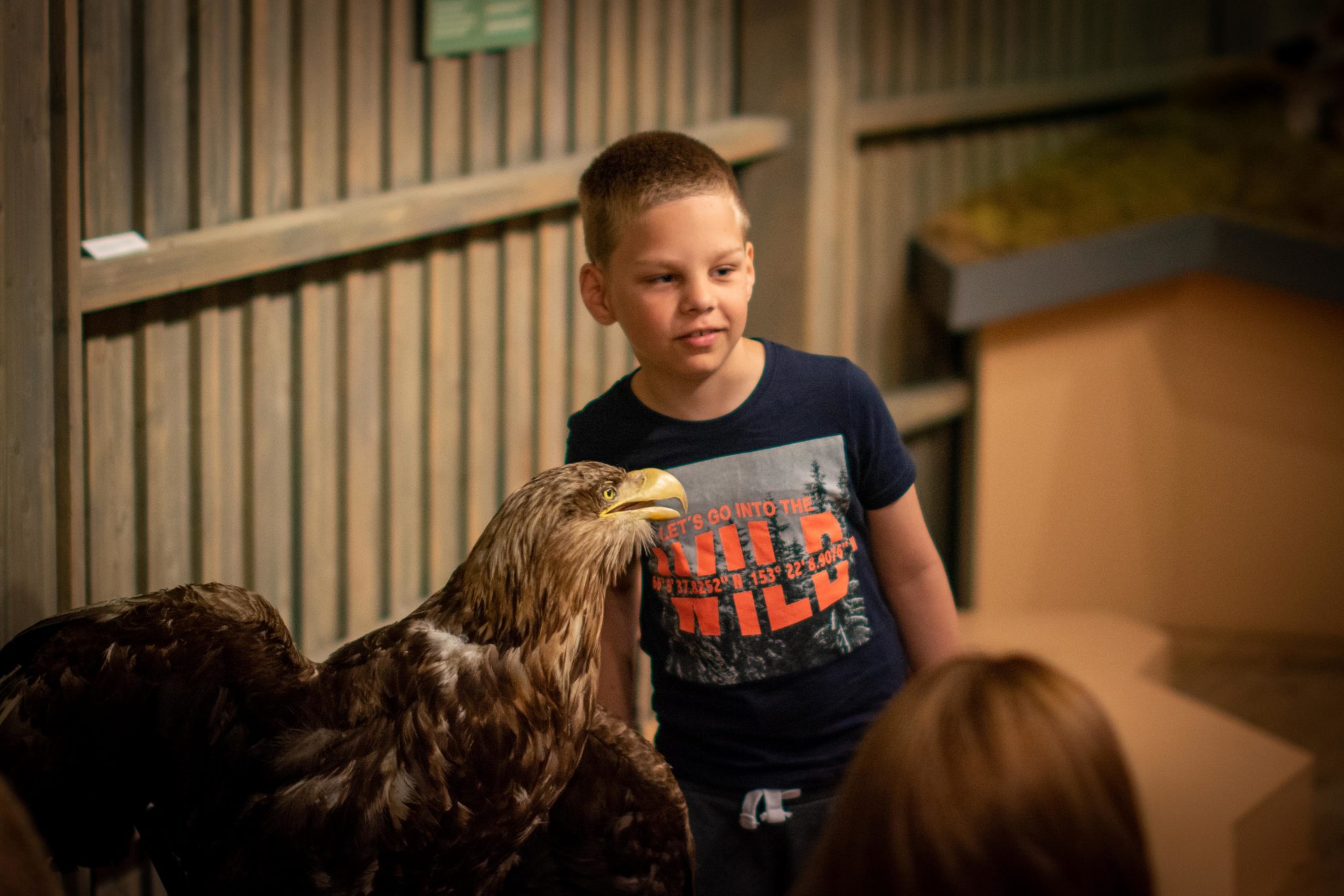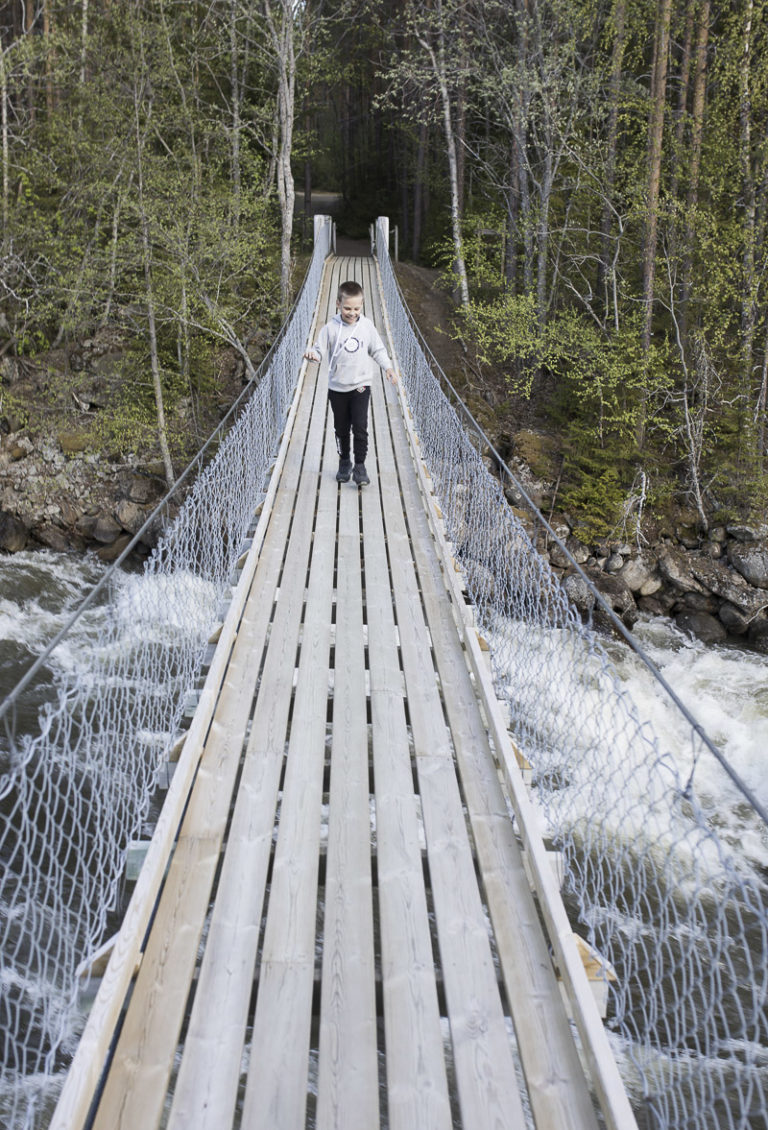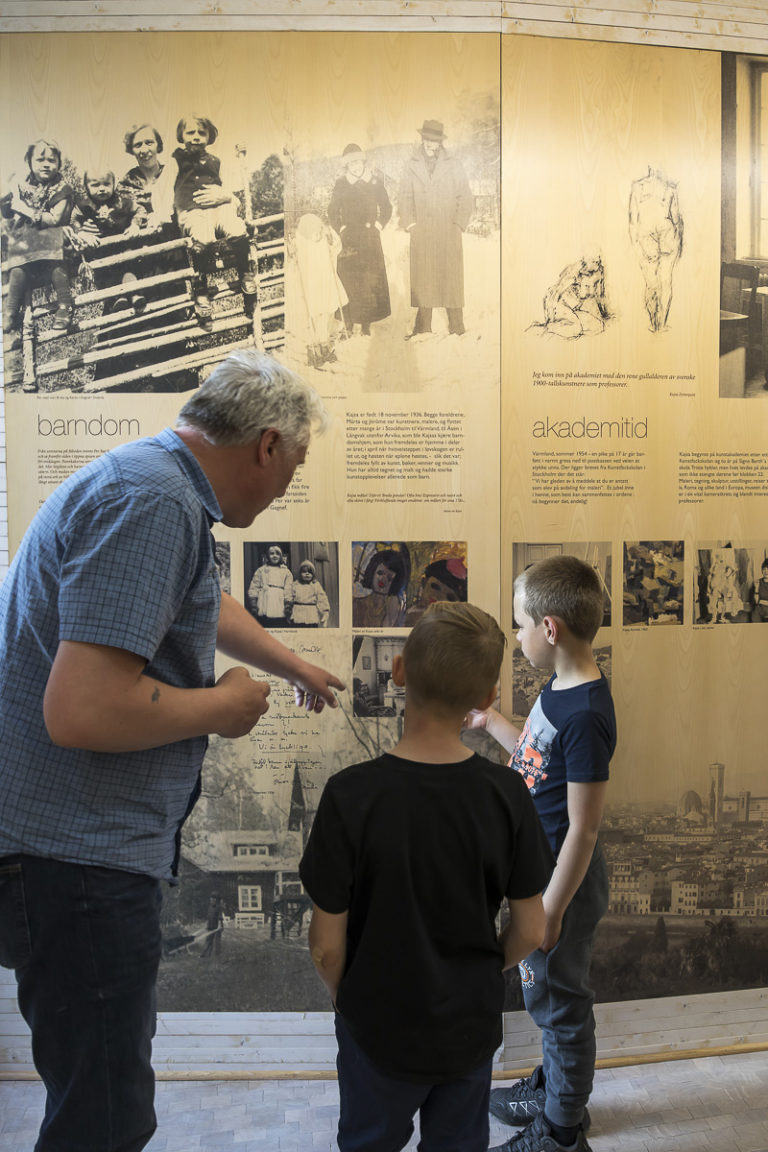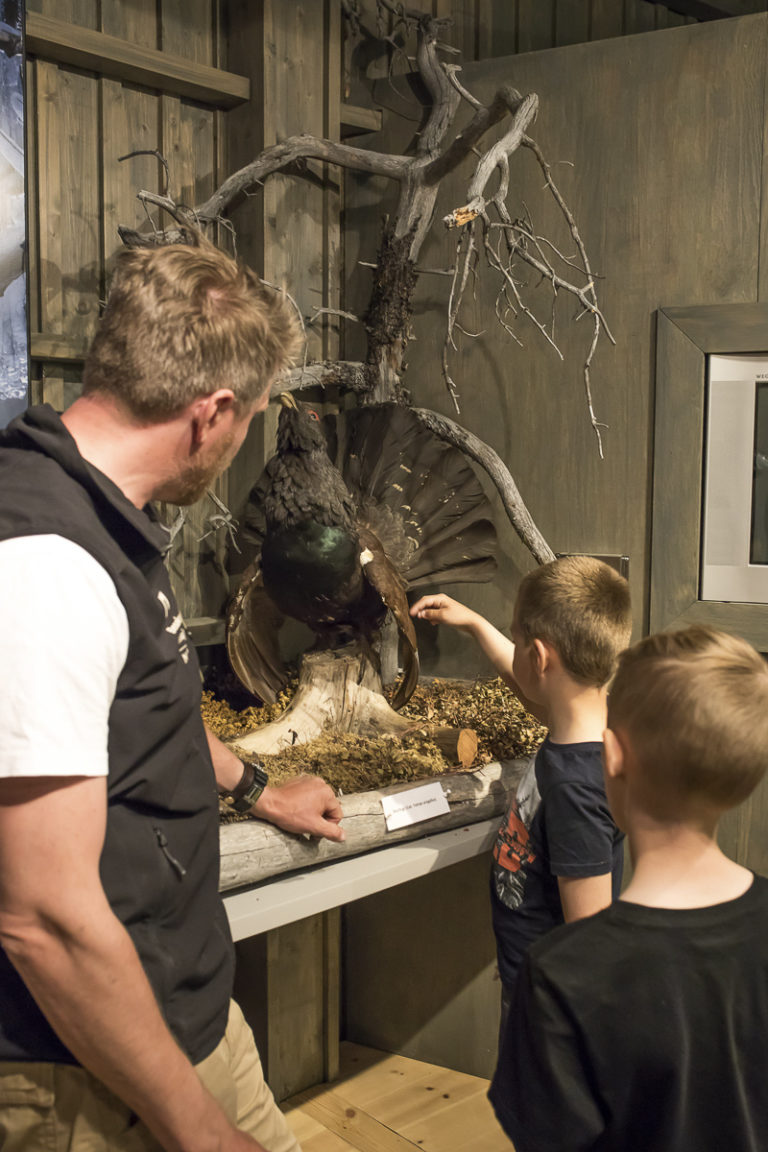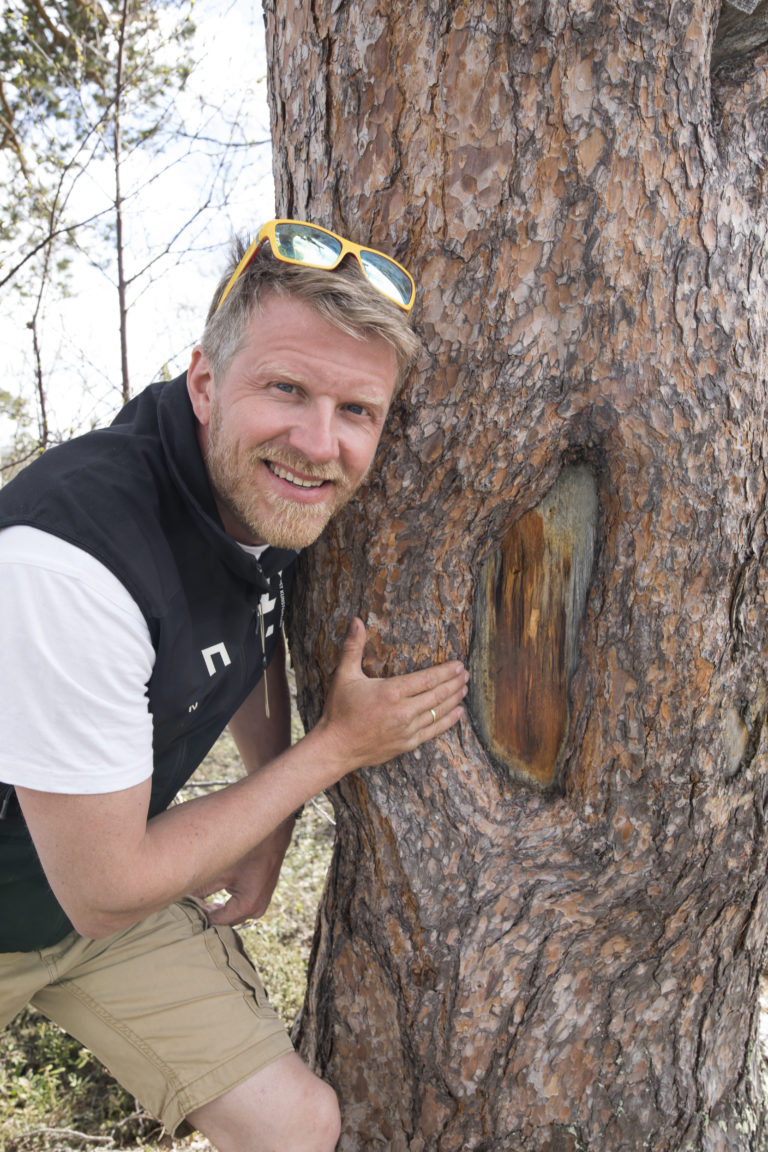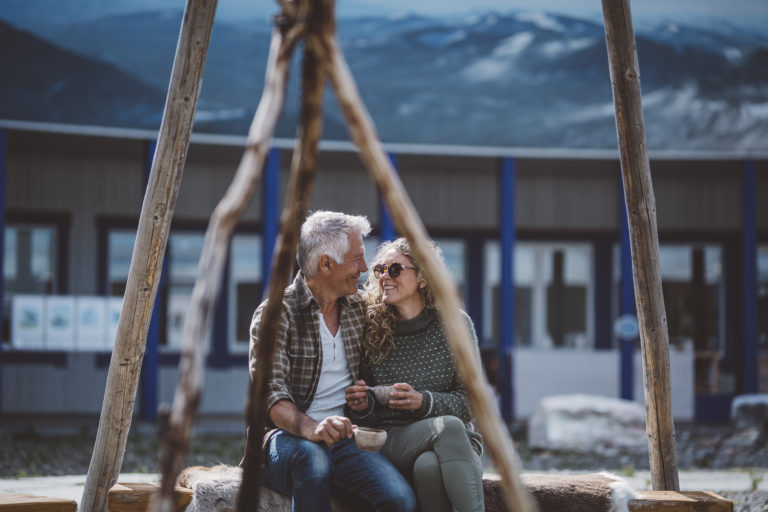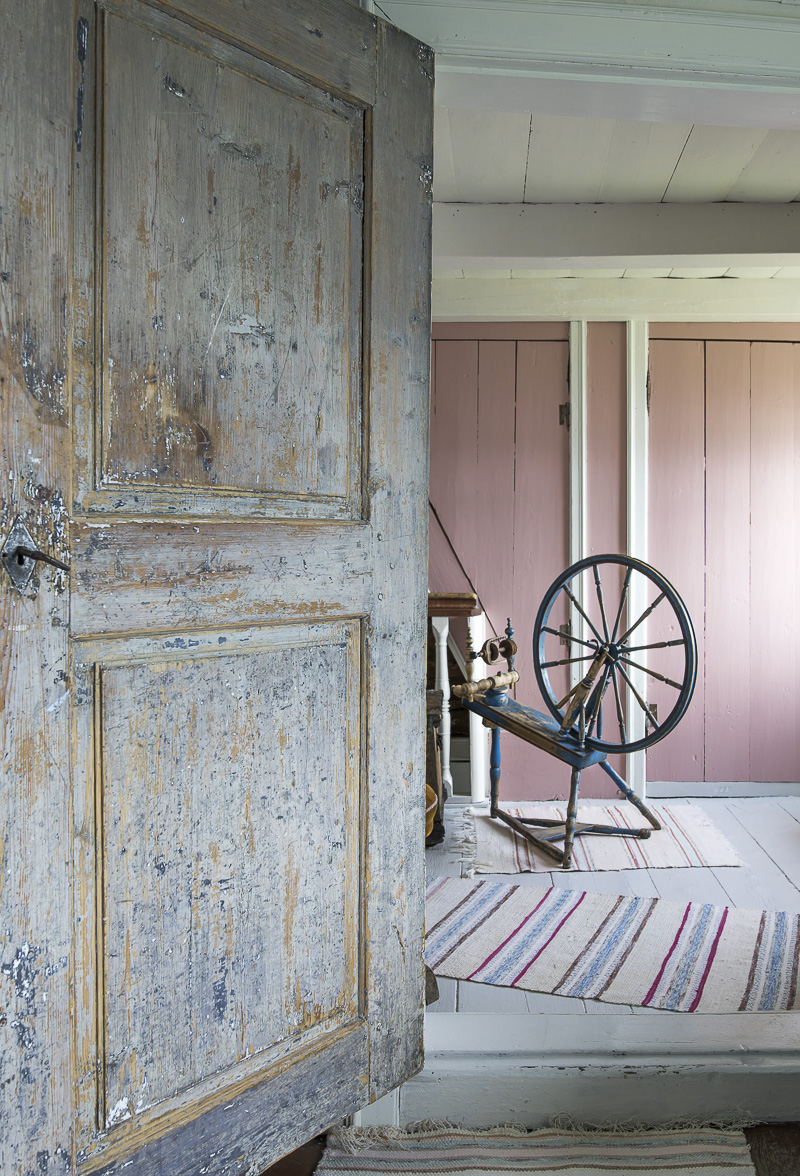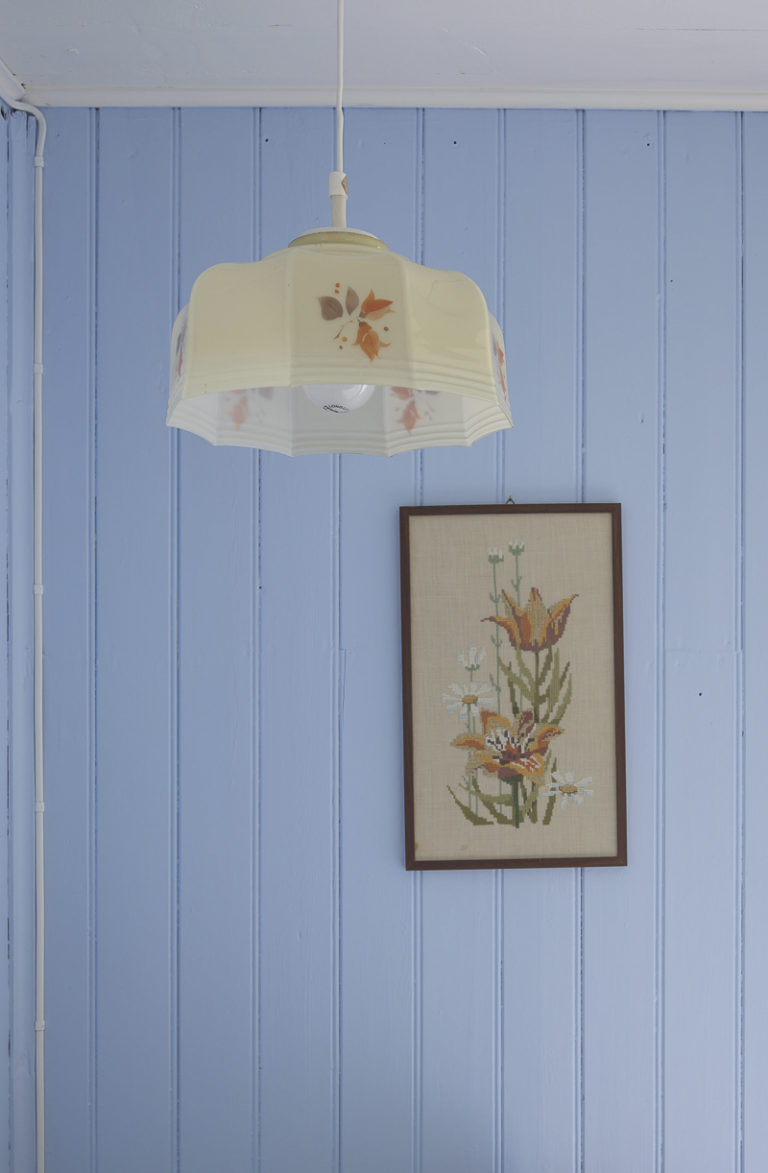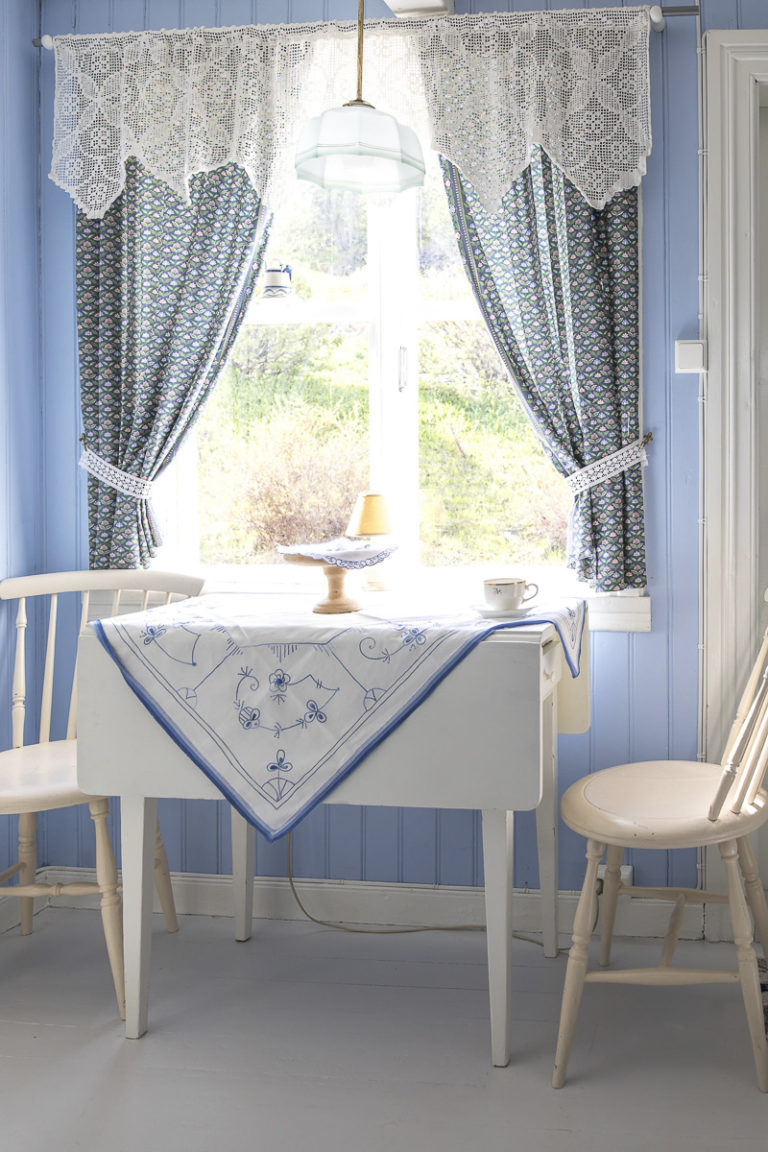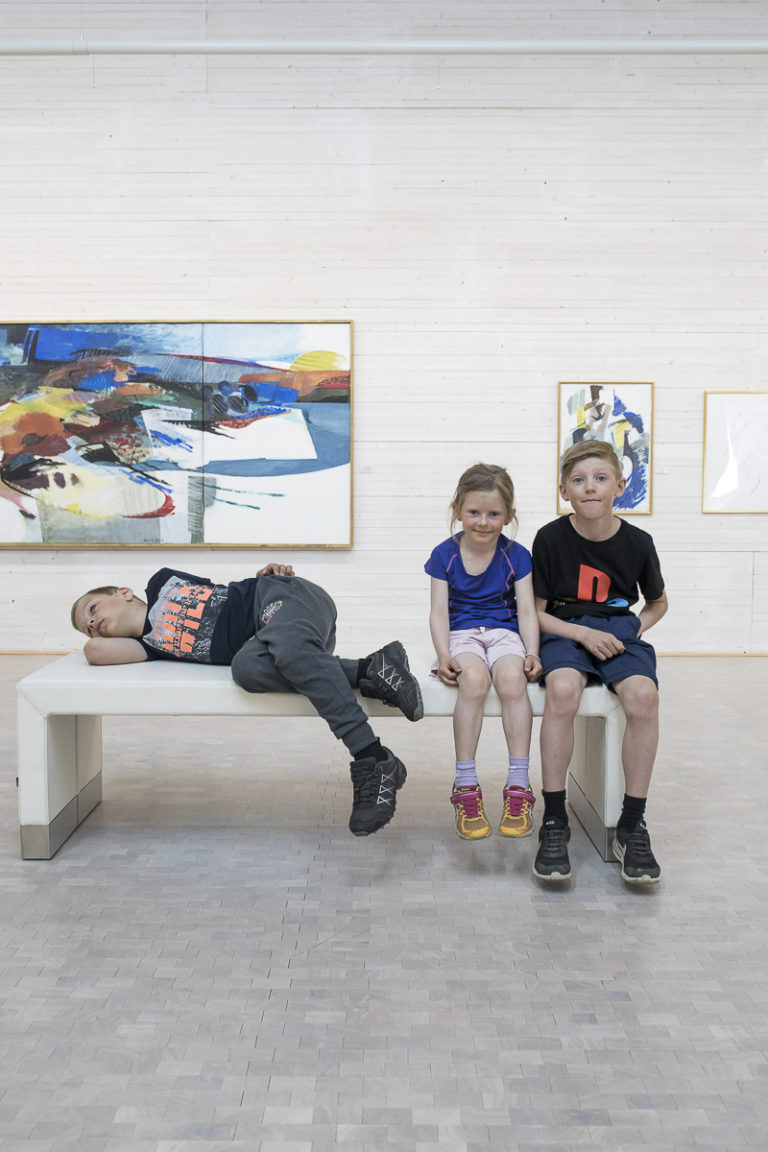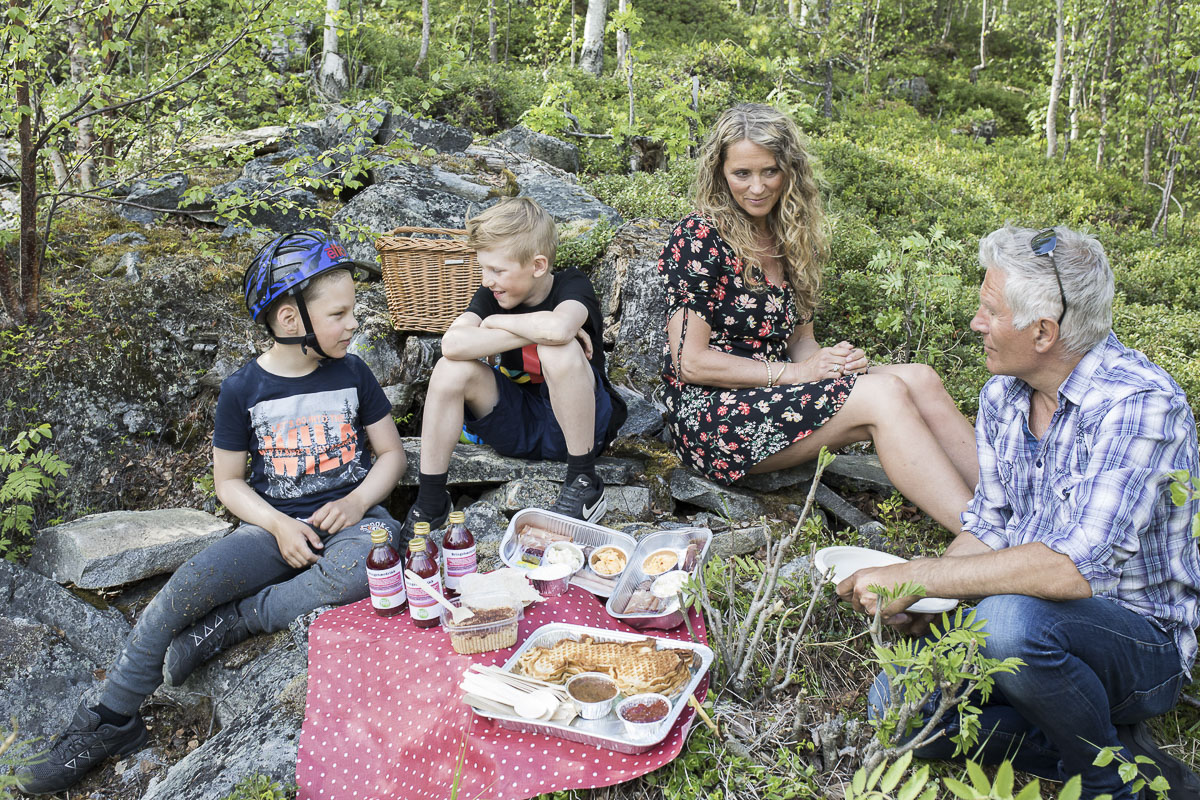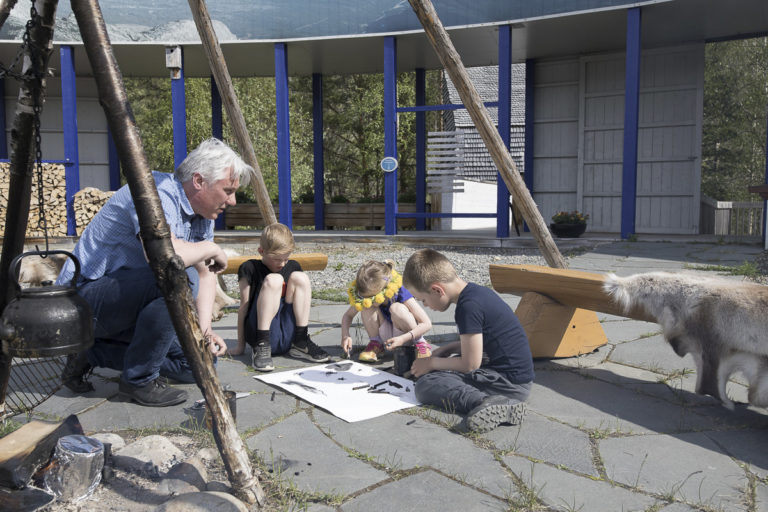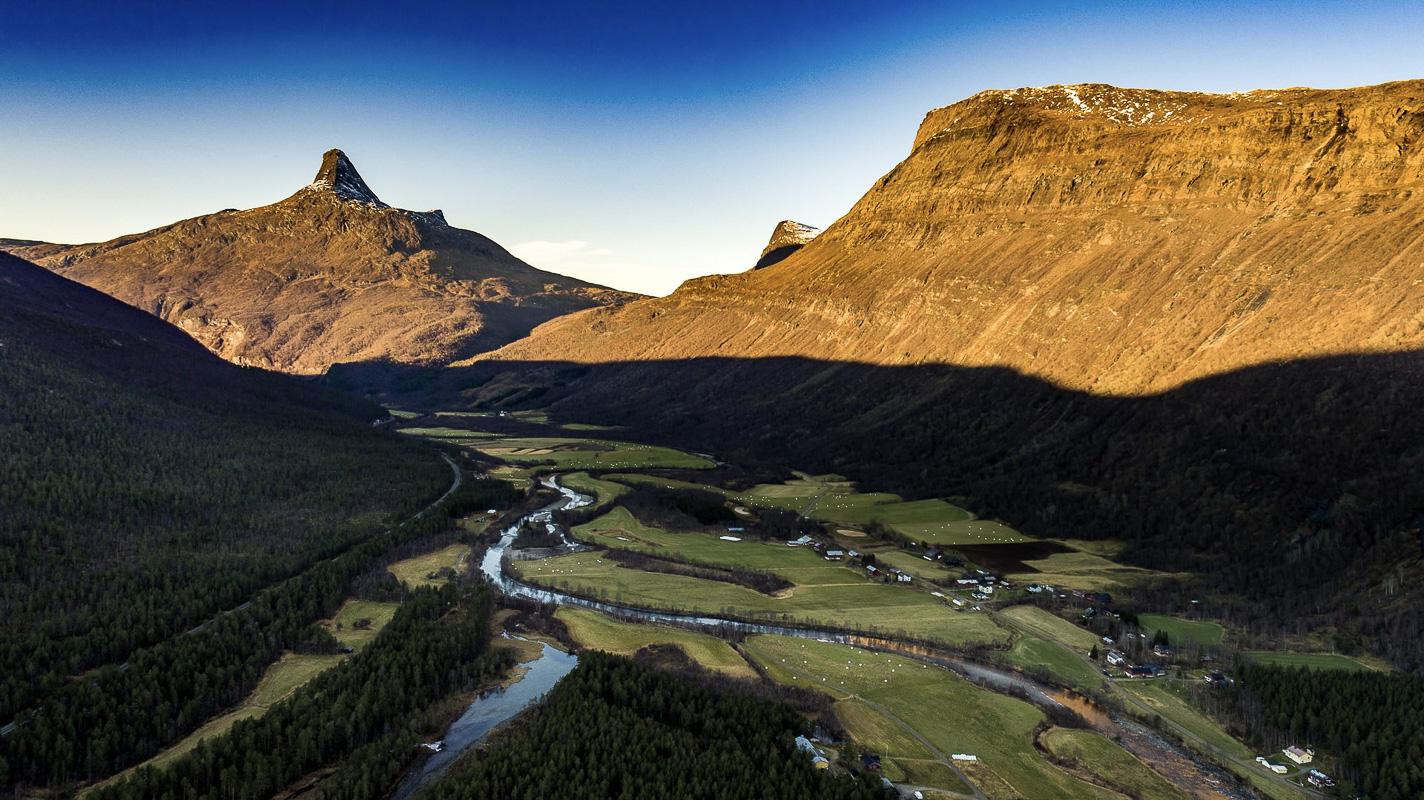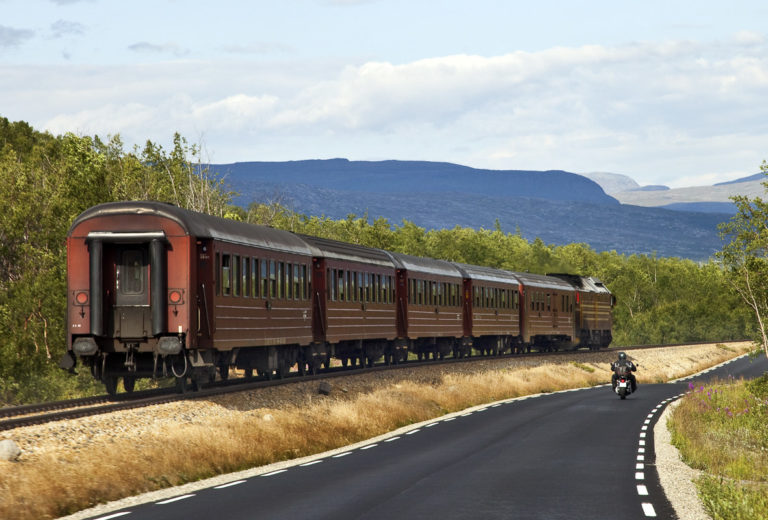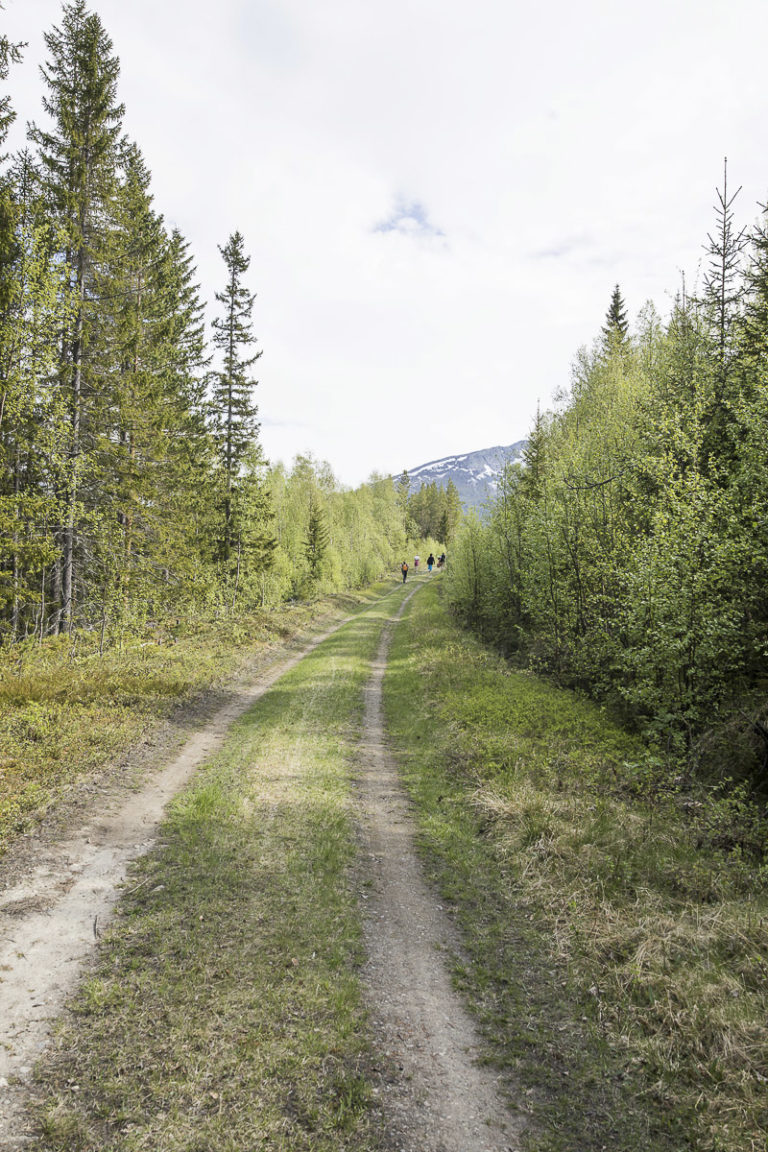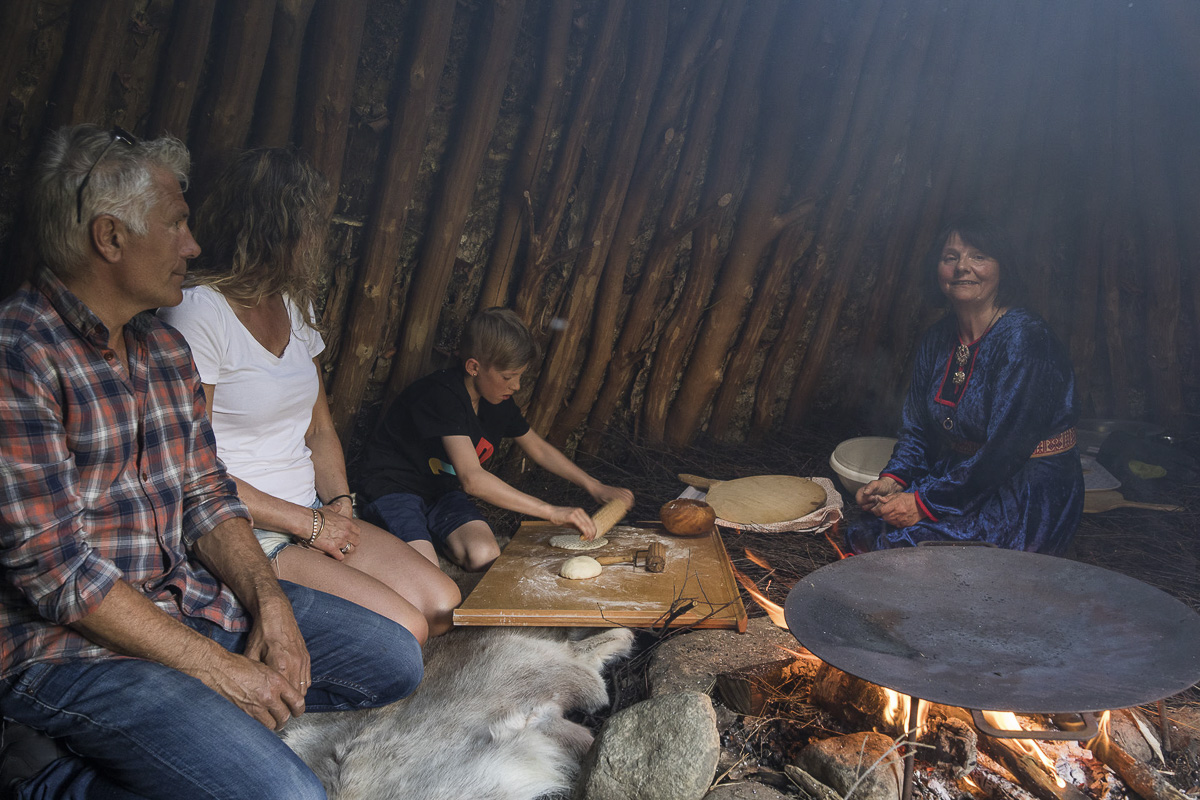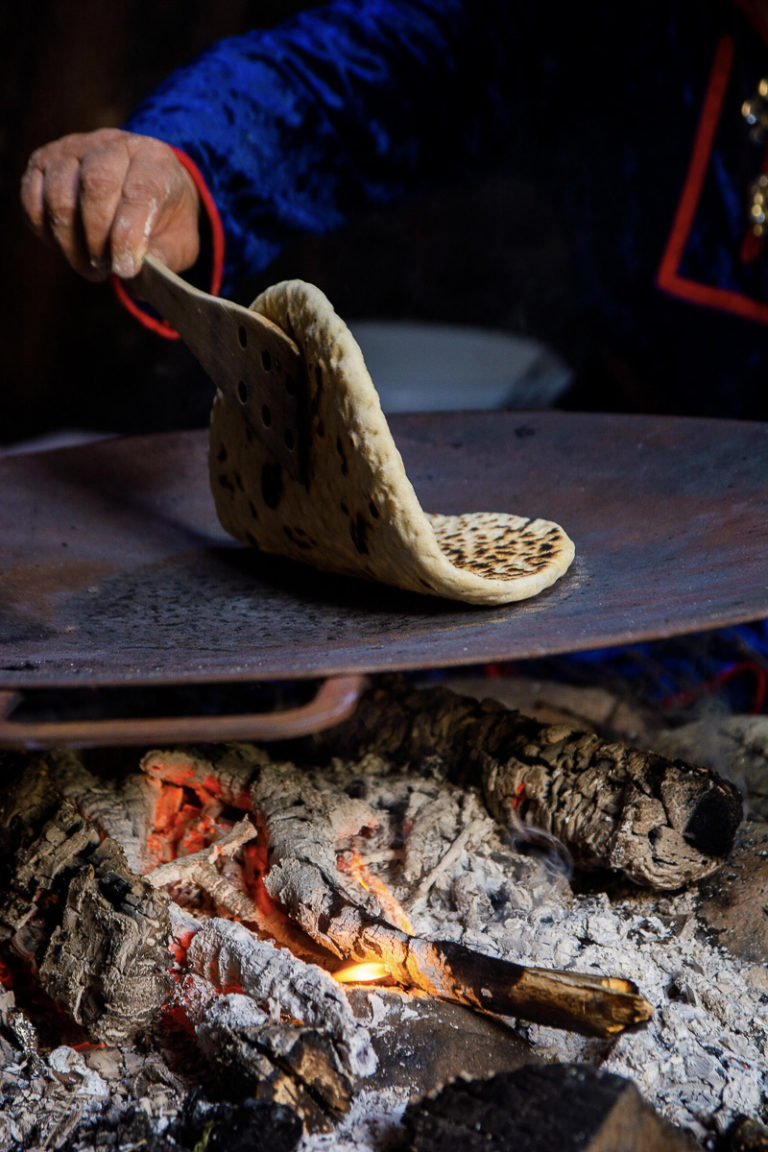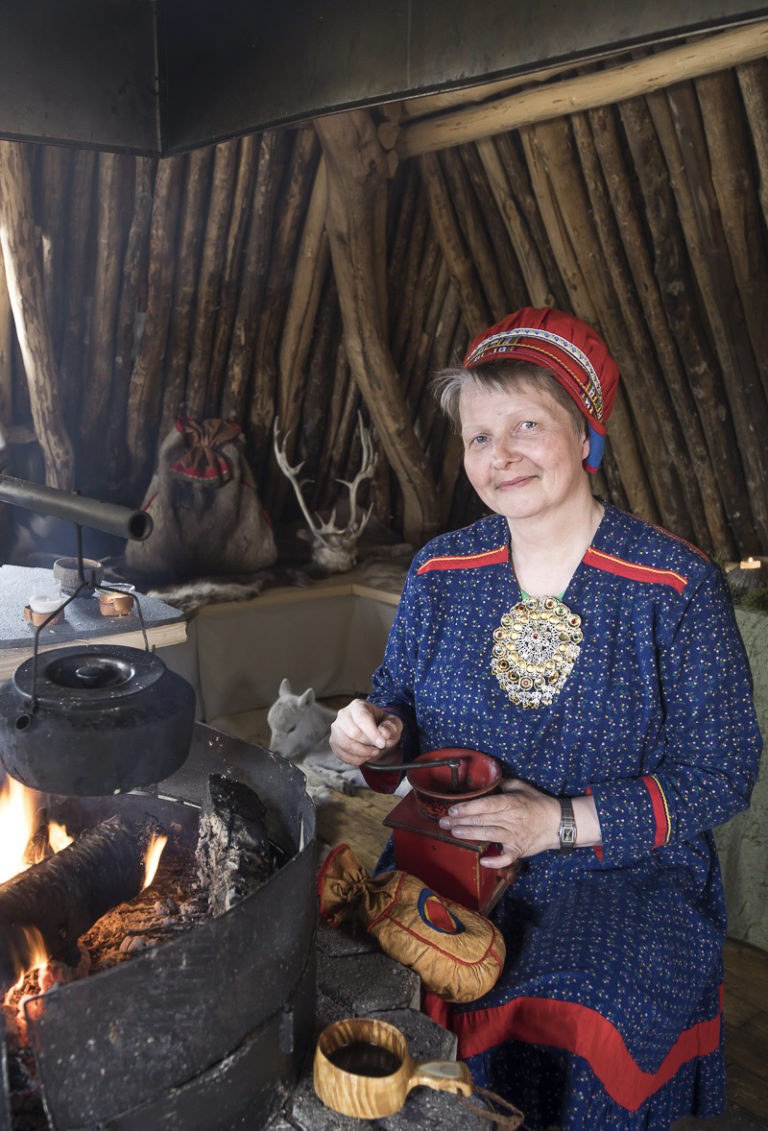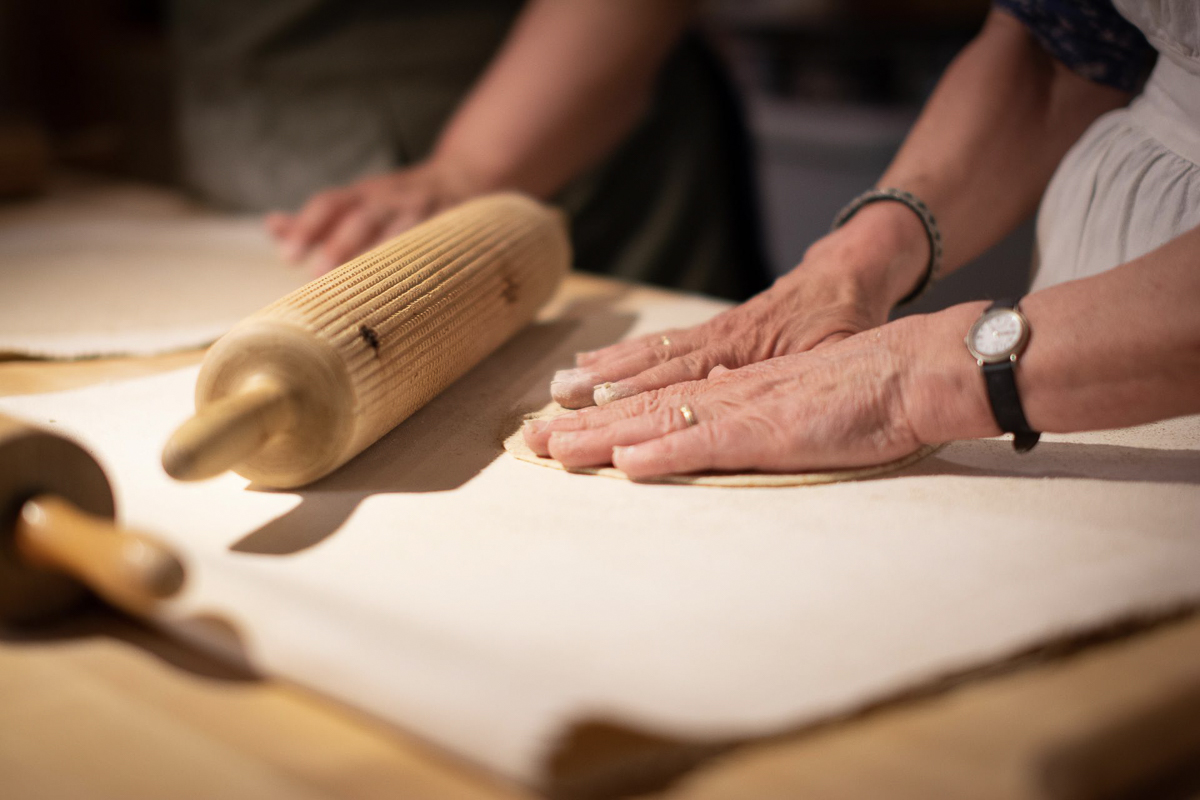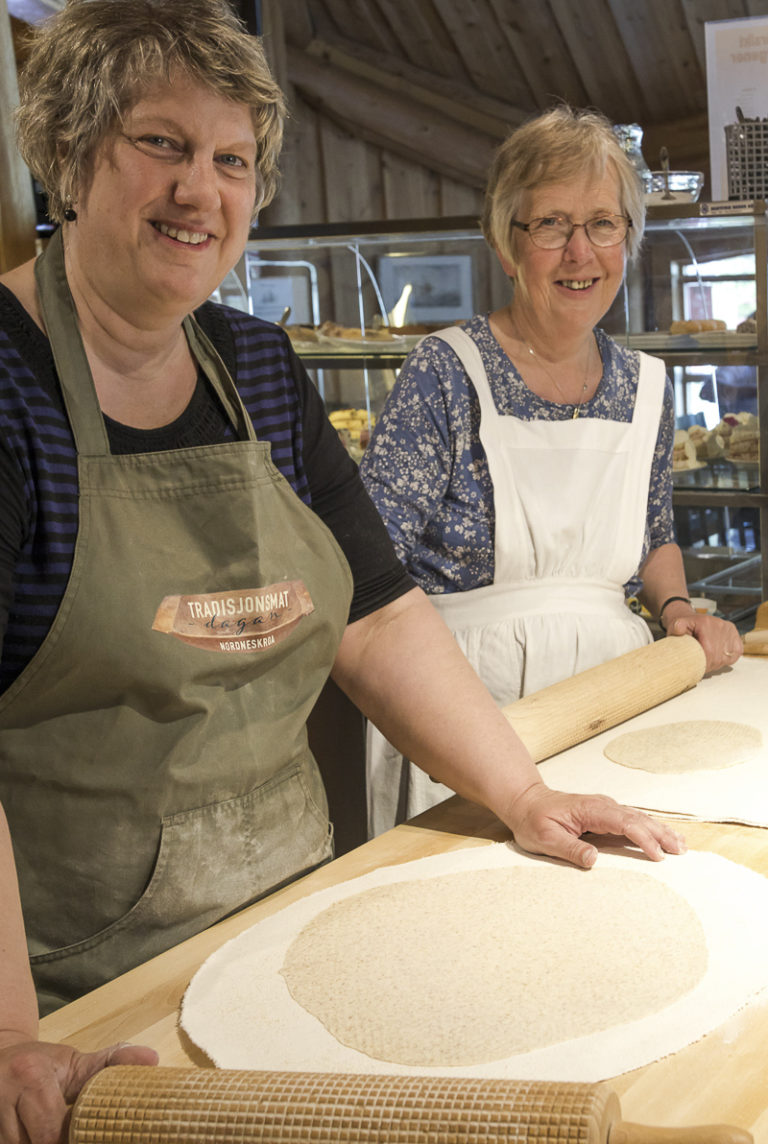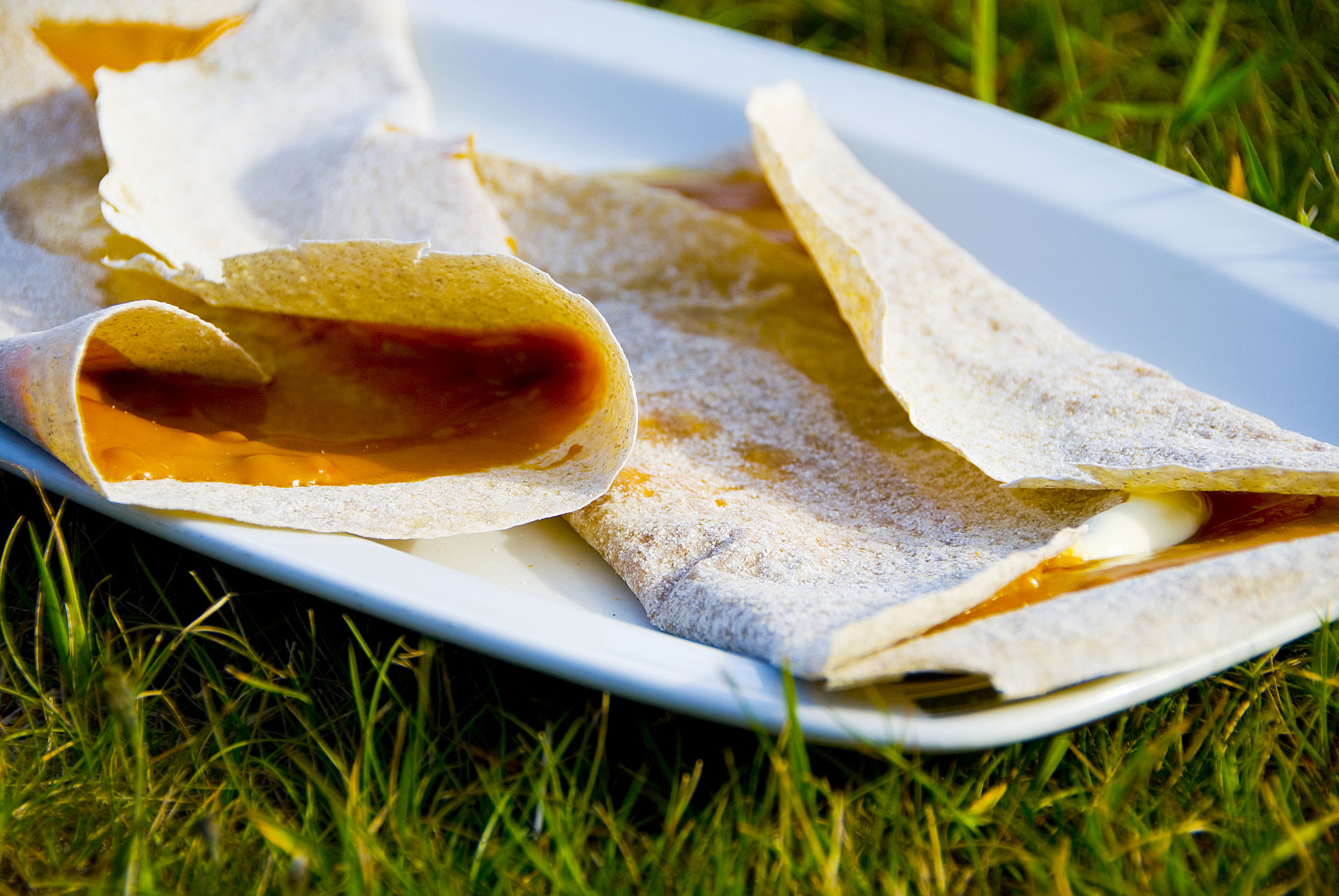The transition to the midnight sun is marked by the wilder nature down from Saltfjellet towards Storjord. The drama and beauty of the landscape can leave you breathless in your train seat. You have been warned! Down in the valley, strong human encounters and a national park center await us that make us want to stay a few extra days on our train trip to Bodø.
As we stretch, we slowly wake up in a charming, old bed
From our room at Storjord Hotel we look out towards a wide and mighty mountain, warmly coloured by the morning sun. When we are ready for breakfast, we take hold of old handles that have become accustomed to unfamiliar hands, over time. Storjord Hotel has long traditions as a guesthouse: We have found shelter for the night in a room with gauzy lace curtains resting against rough axe marks on strong, beautiful timber walls. Here are moonlight lamps and old armchairs with original covers. Worn, but oh so beautiful floors. At Storjord Hotel nostalgic porcelain clinks when morning coffee is served in the breakfast room.
– Auntie, please! Can I have some coffee?
Before I’m about to answer that you’ll have to wait a few years, I see a twinkle in the host’s eyes. Petter is in his usual warm, good mood and my nephew Adam jumps up and down in his chair, roughly, when I answer: Yes, yes; we’re on vacation. But what will mother Tove say to that? Oh yes! You know, vacation! Big eyes beam over a cup of warm milk, with a tiny bit of coffee in it. Mm, very good, the toddler proclaims in a small adult voice. A good travel experience for children can be so many things! Being seen is an important ingredient.
Frokost i en sjarmerende og behagelig, sjarmerende sal
Freshly baked, fluffy scones accompanied by butter seasoned with fresh herbs from the guesthouse garden are pure pleasure, echoed by the ticking of a wall clock that, together with the faint roar of the spring-wild Saltdal River, becomes the finest background music. It tastes sour and fresh. “Cuckoo’s nest was considered a weed before,” smiles Petter Ording, who runs the guesthouse together with his wife Camilla Storjord. In the house where her great-grandparents started a guesthouse in 1923, the hospitable couple offers, in keeping with tradition, a handful of unique rooms as shelter for the night. Just outside, great nature experiences await, with a small forest in front that hides an imperceptible E6 from here. In the summer, a summer café is held here on a few days a week.
In the middle of a coffee shop in the guesthouse garden, a herd of reindeer comes by
Våre gode verter er vante med slikt majestetisk besøk, mens vi lister oss stille til best possible photo position. We are rewarded, and enjoy the sight of the wildlife that has drawn down towards us. We are also rewarded when we make our way by bike in a pleasant, open forest of tall pine trees on a prepared path. The history of the area is well explained on signs in places. Along the way we stop at a dead ice pit, hollowed out by a large iceberg. It was probably buried in enormous masses before it took ten years to thaw, we can read, before just beyond we study the remains of a trap made a long, long time ago, when man trapped reindeer by making invisible holes in the ground. What a beautiful trip it is!
Nordland National Park Center takes us on a visual journey through time
When we cycle back, we continue across a swaying suspension bridge, with a wild river rapids below us. The Queen of the North, as the Saltdal River is affectionately called, rushes wildly below us before we arrive at the visitor center nearby. Technical leader and guide Benny Sætermo is a passionate communicator. He draws long lines as he takes us through tens of thousands of years, all the way to our more immediate, recent past.
We learn that Saltdalen was a fjord during the last ice age
– Which is a really long time ago according to Adam, who counts eight years. Along the natural history trail, he is fascinated when he gets to crawl into a reconstructed fox den. The center is a safe setting for an encounter with nature, where you can challenge your feelings for nature.
The exhibition brings people from bygone times closer to us
Here, the children can take part in a well-designed and exciting trail with wild animals and much more to look at. What a relief it is that they are allowed to touch things. Here, not everything is about show. Learning is conveyed with joy and commitment. An exhibition of Stone Age people in a cave particularly captivates Adam. Here, he gets to see how people dressed and lived in the past. Trembling with enthusiasm, he tells Benny what he learned about the Stone Age when he was at Tuvsjyen by Saltstraumen, where he got to dress up as a real Stone Age boy. Patience is a virtue, Benny listens. And the aunt understands that it is important for her nephew to take part in a conversation, rather than just listening. Seeing people and getting people to see each other is an important part of Benny’s pleasant flow of information.
Sami culture is a powerful experience
When we have put our colours with charcoal pencils, made some impressions on the sheet and tried a variety of outdoor activities, we continue down to Birgit. She is waiting for us out in the field, in a real peat bog, below the visitor centre. Here at Roparneset, a Sami settlement has been built, authentically based on building customs from when people lived like this. When the place is also brought to life by Birgit, who grew up like this until she was nine years old, it is hard to take in how quickly society has changed. She prepares traditional Gahkku over a fire, while we sit on birch rice around her. The situation is comparable to that experienced by those before her 200 years ago, and perhaps even further back in time.
You can’t read about such experiences or watch movies
You have to experience it with your whole being to feel the right feeling. – Everything falls into place when you get a whole, which you get when you come down to Birgit. To a meeting with her that is anything but directed. She has no planned script that she reads out, which is why it feels so good and so real. She accepts what the visitors have in their hearts, says Benny. It is so powerful to meet Birgit as a contemporary witness, a last generation who can convey the atmosphere around her Sami traditions, as she has grown up with them. Dare to ask her questions! She welcomes them warmly. Together you become part of a meeting. We will never forget our meeting with her.
Art is often derived from nature: the two enrich and reinforce each other
Nordland Nasjonalparksenter is located midway between the Saltfjellet/Svartisen and Junkerdalen national parks, and consists of the Adde Zatterquist Art Gallery and the Nordland National Park Visitor Center. The units often form the largest connection: The two hang together. Art galleries have an exciting architectural design that houses a permanent exhibition of paintings. The artist couple Kajsa Zetterquist and Per Adde have both received the King’s Medal of Merit. Their fascinating lives and work are gathered here.
The art embodies a strong commitment to nature conservation, art policy and Sami rights
The art tours held here can be adapted for children, who are often fascinated by the abstract expressions. A walk through such a strong and well-presented life’s work triggers the imagination, which we take with us when we observe and recognize nature from the works of art.
Temperature and movement in Per Adde’s pictures
Art educator Bjørnar K. Meisler has worked at the Adde Zetterquist Art Gallery since its inception in 2013. He shows us the pictures and talks about different ways of looking at them. We who listen and see get a feeling that stress can be like a temperature, like a feeling created by a painted reindeer herd in motion, in close interaction with humans. We who observe and take in the expressions in the pictures are left with a feeling of getting a shortcut to our own emotional life.
The National Park Center is a great starting point for trips
Back in the bag is a friendly lynx in the form of a teddy bear bought from the museum shop. A lynx that is tough enough to pass as a teddy bear for an eight-year-old. – It is a nature experience in itself just to walk to Storjord Hotell from here, says Benny. He reminds us that visitors can get good hiking tips for easy and more demanding hikes. In the museum shop you can buy maps, and at the Saltdal tourist center a short distance away you can have a good meal before you take your legs or wheels.
It is difficult to find a better starting point for entering nature
– At the national park center there is a lot of information available, and you can park your car and then you can set off or paddle down the river to Rognan, take a summit trip to high alpine areas: To class peaks like Solvågtind. We take it a little easy, and also follow the path back, after frolicking in the climbing jungle and playing on the frisbee golf course before we stop before the suspension bridge over to Storjord Hotel.
Benny Sætermo, Visitor Centre National Park Nordland
Happy free campers have sought shelter for the night at a nice picnic area with a campfire site
We only have to walk a few hundred meters before we can frolic in the open air. Here there is a gap and the space is also universally designed. The happy campers have set up camp here, even though they have rented a simple cabin right next to the national park center. The local tourists took their hammocks and bicycles with them on the train from Bodø to Rognan. The cabin that they use as a base while exploring Saltdal is well equipped from a natural point of view with warm valleys, steep, lush mountain sides that merge into high mountains. The couple reminds us that it is not strange the effort it takes to have a great nature experience.
We know the taste of milk chocolate at the sight of Junkerdalen
From the rest area we can look up to Ølfjellet. Benny drives us up a narrow and winding gravel road. As we climb steeply, a beautiful piece of Northern Norway reveals itself. Spending some time on the wild roads to experience the view of the dramatic river gorge in Junkerdalsura is well worth it. The nature reserve is known as a botanical gem and attracted the great Knut Hamsun during his writings. From the rest area in Junkerdal you can look over to the mighty Kjemåfossen waterfall. It is accessible on foot from Storjord.
Lønsdal, the train station of opportunity
If you travel by rail, you can get off in the middle of this fabulous nature. Up the slopes from Røkland station to Lønsdal station, there is a climb of almost 500 meters. To get up here, the train must climb steeply 30 kilometers, from Røkland which is located at just under 24 meters. A train section that was completed in 1955. At Lønsdal, the mountain world is immediately accessible, in one of our protected national park areas. Drive carefully through the summer night. Anyway, have a good trip!
The Nordland Line offers a momentous journey
Above Saltfjellet there is a wealth of Sami cultural heritage
There are many Sami monuments such as sacrificial sites, ancient graves and reindeer gardens and traces of presence here. At Lønsdal station, some trees have traces of the inner bark having been harvested. – It was shaken and crushed into flour, mixed with reindeer milk, says Benny and elaborates: – The value of knowledge is enormous. Learning gives security. In practical terms, you can learn to survive in nature, or learn to make blueberry jam, he laughs, before we continue up towards Saltfjellet to the Oskal family who live off and with the mountain.
The Oskal family is engaged in reindeer herding and welcomes visitors
The Oskal family welcomes us warmly. In the yard right next to their private home and work area is a spacious barn that we are invited into. Here we hear stories about reindeer herding and how their ancestors have made a living from the mountains, just like them. They tell us about their traditions and values in a low voice, over the festive food Bidos, made from reindeer, of course. With their involvement in Saltfjell Sami Adventures and Saltfjell Reinprodukter, they preserve Sami food traditions. We enjoy flavors from pasture to table in front of the fire, while a reindeer calf that lost its mother on pasture lies at its mother Nina’s feet. It has been a long time since the family has had a bottle-fed calf with them. We are careful not to disturb it too much.
What is the Arcrtic Circle?
Elin Kristina Oskal is the Sami voice of “Anna” in Disney’s animated film, “Frozen 2”
The family is both proud and happy about Elin’s efforts. The fact that such a major initiative is voiced in the Sami language is something that mother Nina and sister Anne Margaretha are delighted about. – For the recording, Elin Kristina had to learn even more about the language along the way. During the meeting in the gammen, Anna Margaretha also explains to us about the panels on the costumes that she and mother Nina wear. They tell us something about where they originated. We are fascinated by the fact that there is so much history in the textiles they wear. While Anne Margaretha is telling the story, little Elida sits quietly on a bench next to her, listening as if spellbound. The situation is close, and once again we experience that questions are warmly welcomed, especially those that are detailed and a little outside the most obvious questions. Feel a little extra before you ask, is our advice
We spend more time in each place than we think in advance
Simply because we know with all our heart how important it is to be present in the experiences we have, there and then. That’s how the trip becomes so rich. On the way we also turn into Rognan, which became a lively community after mostly housing the boathouses of the valley and mountain farmers. The sea was their means of transport, the road over Saltfjellet did not come until the late 1930s. From the late 19th century there was a steamship wharf, telegraph and bank that attracted merchants, craftsmen, workers, fishermen and civil servants. Because Rognan was hit by fire, the place is characterized by a rough but exciting mixed architecture. By the harbor you can still hear the sound of large halls where there is still operation in a real boatbuilding, where boatbuilder Kai Linde is happy to talk about this tradition. A little further on you can stay overnight at Halsgården, a beautiful Nordland house above rocky cliffs from which it is exciting to fish.
Møsbrømlefsa is popular: Freshly fried on a griddle and crispy, that’s how it should be
In the summer, you can experience real-life pastry chefs at Nordneskroa, between Storjord and Rognan. If you’re daring, order one with some old-salted saithe. – Ah, can you send me a lefse over the phone, sighs mother Sigrid. She was raised on such food, and misses it, after she made a fool of herself many years ago. I guarantee you, you’ve probably never tasted anything quite like it!
On the way to Møsbrømlefsa, you may, like us, encounter reindeer grazing on the roadside.
Drive carefully! Relatively close to the inn, which also serves food you’ve heard of before, you can turn up the recently improved volunteer road over Misværfjellet. A nice detour if your destination is Bodø. I myself experienced driving on the Snaufjellet mountain at times on my way to my childhood summer holidays with my grandmother Ragna in Breivika. Before we got there, we stopped at rest areas and cultural monuments that you now have to walk to since the road over Saltfjellet has been rebuilt. In an album I find a faded photo of myself as a child, at a rest area on Saltfjellet. It is in Salten that I have the fondest summer memories.
Facts about Saltdal
Saltdal is a municipality within the large Saltfjord and Saltstraumen. At the innermost part of Skjerstadfjorden it is called Saltdalsfjorden and here is the municipal center Rognan. Saltdalen then continues south and up towards Saltfjellet, and the last one you meet before the mountain is Storjord. Then you come up to the high mountains, cross the Arctic Circle towards Rana municipality in the south. Junkerdal is a side valley from Saltdalen that goes east towards the Swedish border.
The Nordlandsbanen railway runs through Saltdal, and has three train stops in the village at Rognan, Røkland and Lønsdal. The E6 runs through the whole of Saltdal, and the RV77 takes you to and from Sweden via the Silvervegen, which ends in Skjellefteå and Nordbotten.
Visit Bodø has a useful information about and the whole region of Bodø/Salten, while Visit Saltdal are more spesific about Saltdal.
